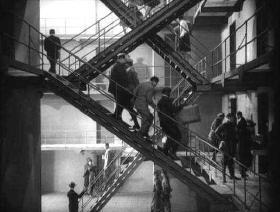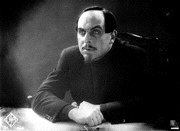
Fritz Lang's Criminal MastermindsLang resurrected Mabuse for Das Testament von Dr. Mabuse in 1931 - the film which got banned by the Nazis - and (according to him) caused him to leave Germany in a hurry when they offered him a senior post in film propaganda. (It's a good story, which he told frequently: it's just that it's not true.)  With
Spione (Spies) in 1928 (now available in a restored version on DVD), Lang created a
well-constructed and exciting thriller. The evil Haghi (Klein-Rogge again) sits
in a secret room in the bank he owns, at the centre of a large criminal
conspiracy. Controlling his minions by telephones and message flashed on
screens, he organizes the theft of secret diplomatic documents (though exactly
why is never made clear). Willy Fritsch (better known for his 1930s
frothy musicals) is a police undercover agent known only as no. 326: Gerda
Mauris is the beautiful Russian woman Haghi sets to entrap him. She and no. 326
fall in love, and work to thwart Haghi's theft of a secret German-Japanese
treaty (the publication of which would cause
war). With
Spione (Spies) in 1928 (now available in a restored version on DVD), Lang created a
well-constructed and exciting thriller. The evil Haghi (Klein-Rogge again) sits
in a secret room in the bank he owns, at the centre of a large criminal
conspiracy. Controlling his minions by telephones and message flashed on
screens, he organizes the theft of secret diplomatic documents (though exactly
why is never made clear). Willy Fritsch (better known for his 1930s
frothy musicals) is a police undercover agent known only as no. 326: Gerda
Mauris is the beautiful Russian woman Haghi sets to entrap him. She and no. 326
fall in love, and work to thwart Haghi's theft of a secret German-Japanese
treaty (the publication of which would cause
war). This
is the world of sub-miniature cameras, messages in fading ink, hidden
microphones and secret radio transmitters, a train crash engineered to kill one
man, a car chase, the heroine bound to a chair and in imminent danger of death,
poison gas, a race against time to find a bomb; and a theatrical clown who is
not what he seems. With this film, Lang set the standard for every spy thriller
which followed, all the way to James
Bond. This
is the world of sub-miniature cameras, messages in fading ink, hidden
microphones and secret radio transmitters, a train crash engineered to kill one
man, a car chase, the heroine bound to a chair and in imminent danger of death,
poison gas, a race against time to find a bomb; and a theatrical clown who is
not what he seems. With this film, Lang set the standard for every spy thriller
which followed, all the way to James
Bond.He invented one other enduring tradition: in his 1929 science-fiction film Frau im Mond (The Woman in the Moon) he showed a rocket launch so realistic that the Nazis tried to destroy every copy during World War II and the development of the V2: and invented (for purely dramatic reasons) the count-down to launch which has been a feature of every real-world rocket launch since then. Posted: Tue - June 19, 2007 at 09:25 AM by Roger Wilmut |
Quick Links
About Me:
Roger Wilmut XML/RSS Feed
MY PODCAST
Archives
Calendar
Blogroll
WEBRINGS
Statistics
Total entries in this category: Published On: Mar 11, 2016 05:00 PM |
||||||||||||||||||


